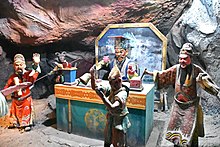Haw Par Villa

Burmese-Chinese brothers Aw Boon Haw and Aw Boon Par, the developers of Tiger Balm, moved their business from Burma to Singapore in 1926. The site, which is in front of a small hill and faces the Singapore Strait, was deemed suitable based on considerations of feng shui,[1] and was purchased in 1935. On the site, a Har Par Villa was being built for the next two years.[2] The villa was designed by Ho Kwong Yew and was of Art Deco architecture.[2][3] The villa was bombed by the Japanese during the World War II,[4] and was subsequently occupied by them.[3] After the war ended, the villa was demolished.[3] Between 1937 and his death in 1954 (when the garden was declared public property, and turned into a park), Boon Haw commissioned statues and dioramas in the garden that served to teach traditional Chinese values.[1]

In the 1950s and 1960s, before the advent of television and shopping malls, the park was a popular recreational destination for Singaporean families.[1] Many Singaporean adults, in a 1995 survey, reported memories of visiting the park as a child and learning about Chinese folk history and morality.[1]

In the 1980s, in a bid to restore Singapore's "oriental mystique", Singapore Tourism Board saw to the redevelopment of the park (along with Chinatown and Little India).[1] In 1986, the International Theme Parks Pte Ltd, announced an investment of $30 million to modernise the themed park. This company was a joint venture formed by Fraser & Neave and Times Publishing, and had invested in the latest animatronics and technology to enhance the attractions in the hope to create an 'oriental Disneyland', a theme park meeting Western technology with Eastern mythology.[5]
In 1988, Singapore Tourism Board took charge of the Tiger Balm Gardens and renamed it "Haw Par Villa Dragon World". The Haw Par in the park's name is based on the Aw brothers' personal names—Haw and Par, which mean "tiger" and "leopard" respectively. The dioramas and statues were restored, while plays, acrobatic displays, and puppet shows were organised and held there. The management imposed entrance fees but the high fees discouraged visitors, so the management incurred a loss of S$31.5 million over 10 years. The park management made a profit during its first year of operations after renovations in 1994, broke even in 1995, but started incurring losses over the next three years and was forced to provide free entries in 1998. In March 2001, the Singapore Tourism Board renamed it "Tiger Balm Gardens".[6] The park is now open every day from 9 am to 10 pm (with last entry at 9:30 pm) and admission is free. The Hell's Museum requires an admission fee of SGD$18 for adults and SGD$10 for children.
Between March 2006 and March 2012, the S$7.8 million Hua Song Museum, which focused on the Chinese diaspora, operated within the park.[7]
In 2014, artists Chun Kai Qun, Chun Kaifeng and Elizabeth Gan, under the curatorial platform Latent Spaces, staged four exhibitions in the theme park's unused spaces. Their first exhibition, Nameless Forms, featured the works by the Chun twins, Darren Tesar, Sai Hua Kuan and collective Yunrubin, which respond to the place's defunct exhibition halls, idle pavilions and the materials that were left behind.[8]
In October 2020, Haw Par Villa was closed for renovations and reopened on 1 July 2021. It was originally to be reopened on 31 March 2021 but was delayed due to park operator, Journeys, needed more time to “further enhance its offerings”[9]





























Afegeix un nou comentari